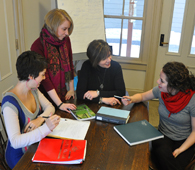|
Demographic Factors at Play in Community Responses
HOLYOKE, Mass. — The success of grassroots public health and environmental mobilization efforts is often influenced by the makeup of the residents affected, say four area college students who researched recent cases in the nearby City of Holyoke.
 Smith students Mia Teitelbaum, Teresa Kenyon and Elizabeth Bieber, and Mount Holyoke student Sarah Krautheim conducted the project as part of their course on community based research with Smith sociologist Ginetta Candelario. They will share their findings Saturday, Feb. 7, at noon in El Mercado, 413 Main St. Smith students Mia Teitelbaum, Teresa Kenyon and Elizabeth Bieber, and Mount Holyoke student Sarah Krautheim conducted the project as part of their course on community based research with Smith sociologist Ginetta Candelario. They will share their findings Saturday, Feb. 7, at noon in El Mercado, 413 Main St.
For their project, the group compared the current community response to the proposed location of a solid waste transfer station in Holyoke to a pair of past projects that inspired community outcry and, ultimately, did not go forward.
The earlier examples include the proposed expansion of a quarry on Mount Tom, and the proposed construction of a resource recovery plant – essentially an incinerator to burn waste and generate steam for energy production – the same area as proposed for the solid waste transfer station.
All three examples inspired similar public outcry and arguments about their environmental impact, according to the students. In the current case of the solid waste transfer station, a facility that would process between 500 and 750 tons of waste per day, those arguments include pollution from trucks transporting waste, and the proliferation of disease-carrying rodents.
However, differing income and education levels among the people involved in the community groups appeared to influence the overall efforts against the project, the students added.
While the public hearing about the quarry drew hundreds of people, the waste transfer station proposal is largely unknown by residents in the affected district and an early hearing about the project drew only a handful of objectors, they said.
Several factors may have contributed to the low turnout at the city meeting, added Teitelbaum. The population affected by the solid waste transfer station does not have a high rate of vehicle ownership, which means they must use other forms of transportation to access city meetings. And, while the district has a high percentage of Spanish-speaking residents, the initial city meeting did not provide a Spanish translator.
“Puerto Ricans, who comprise almost half of the city’s population, are systematically underrepresented within Holyoke’s political landscape, effectively silencing their opinions,” said Krautheim.
Another similarity among the three projects is the formation of ad hoc groups to object to the plans. However, the demographics of each of the three groups appear to be different, students said.
The group formed to attempt to scale back the solid waste transfer station is dependent upon volunteers, almost all of whom either hold other jobs or are fulltime students. By contrast, the quarry expansion proposal involved the support of several offices and organizations, such as the state Department of Environmental Management, the U.S. Fish and Wildlife Service, and the Trustees of Reservations. The group that responded to the resource recovery plant had the support of several consultants and experts willing to work pro bono.
“What needs to happen now is for the entire community…to take interest in the health, space and safety of not only the most powerful but, more importantly, the already disadvantaged,” said Teitelbaum.
-30-
|























